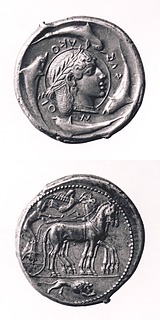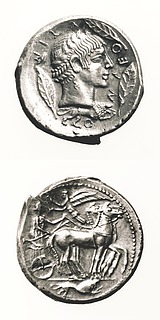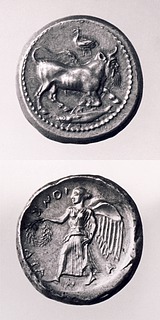Thorvaldsen's Numismatic Collection
- Otto Mørkholm, arkivet.thorvaldsensmuseum.dk, 1982
- Translation by John Kendal
- This is a re-publication of the article:
- Otto Mørkholm: ‘Thorvaldsen’s Coin Collection’, in: Meddelelser fra Thorvaldsens Museum (Communications from the Thorvaldsens Museum) 1982, p. 7-26.*
For a presentation of the article in its original appearance in Danish, please see this facsimile scan. For a presentation of the article in its original appearance in Danish, please see this facsimile scan.
- Otto Mørkholm: ‘Thorvaldsen’s Coin Collection’, in: Meddelelser fra Thorvaldsens Museum (Communications from the Thorvaldsens Museum) 1982, p. 7-26.*
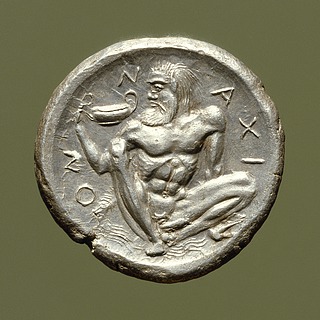
Tetradrachm from Naxos in Sicily. Silver. C. 460 B.C. The coin’s backside shows a sitting satyr holding a drinking cup. 3:1. The Thorvaldsen Museum.
Abildgaard’s Influence
In the Thorvaldsen Museum there are, together with the artist’s other private collections, a considerable number of ancient coins. According to the catalogue published in 1850, Thorvaldsen’s coin collection contains 3,467 coins, the greater part of which, 2,794 items, is made up of what is generally termed Greek coins, while the remaining 673 are Roman and Byzantine.
It is unfortunate that detailed research into Thorvaldsen’s relationship to ancient coins is rendered impossible by the absence of archive material. We have no preserved bills or diary entries that can give us an impression of the growth of the collection. Nor, as far as is known, have references to or comments on the collection been found in Thorvaldsen’s correspondence. One basic reason for this is that, presumably because of his lack of formal schooling, Thorvaldsen was an extremely reluctant letterwriter, who put pen to paper only in cases of dire necessity. I shall, therefore, in the following be limited to a very general picture of some of the people and circumstances that must, in all probability, have been of importance for Thorvaldsen’s interest in this aspect of antiquity.
It is generally recognized that the person who meant most for the young Thorvaldsen’s artistic development was the painter Nicolai Abildgaard, who was a professor at the Academy. Abildgaard did the drawings for a series of excellent medals and was himself, as a result of his stay in Rome, a keen collector of ancient coins. At his death in 1809 he left behind him a considerable collection, which was sold by public auction in 1817.
The auction catalogue comprises 3,776 coins, of which 523 were Greek. Among these there is a series of beautiful silver coins, mainly from Southern Italy and Sicily. It is not unlikely that the first ancient coins Thorvaldsen became acquainted with were selected specimens from Abildgaard’s collection.
Meeting Zoega
In March 1797 Thorvaldsen arrived in Rome, where he was to remain for more than 40 years. Here he met a new mentor in the person of the archaeologist and numismatist Georg Zoega, who had been living in Rome since 1783. For personal reasons he had decided against returning to Denmark, where a position as the director of “The Royal Cabinet of Coins and Medals” awaited him. Besides the ties of his marriage to a young Roman girl and his conversion to Catholicism, he was bound to the city by the fact that only here, through his daily intercourse with the numerous ancient monuments both in the streets and in the great art collections, could he achieve that profound understanding of ancient art that made him one of the founders of the science of archaeology.
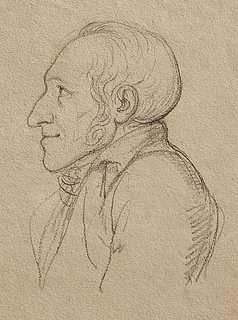
Fig. 3. Bertel Thorvaldsen: ‘Georg Zoega’, (1755-1809).
Black chalk. Detail. C79v
Zoega had begun by specializing in numismatics, and his important work on Alexandrian coins was published in 1787. From 1799 until his death in 1809 he was busily engaged in acquiring ancient coins, both individual specimens and entire collections, for the Coin Cabinet in Copenhagen, where there was an interest in expanding this particular part of the collection, with the publication of a scientific catalogue in view. It can, therefore, be assumed that Zoega, who in general acted as the young Thorvaldsen’s guide in the field of antique art, must have extended his knowledge of ancient numismatics. In this as in other areas he furnished Thorvaldsen with the cultural education that the latter so sorely lacked. However, the young artist’s extremely difficult financial circumstances during the first years of his stay in Rome can hardly have permitted him to collect antiquities to any significant extent.
Meeting Brøndsted
At Zoega’s death in 1809 Thorvaldsen lost his expert guidance, but by this time his fame as a sculptor was already so established and his finances so much improved that he could begin as a collector, an activity which, besides coins, included paintings, drawings, antiquities and books. In the year of Zoega’s death Thorvaldsen made the acquaintance of the young archaeologist P. O. Brøndsted, who spent 1809-10 in Rome on his way to Greece, where his great scholarly journey extended from 1810 to 1813. Brøndsted had already begun to collect antiquities and coins, and his journey through Greece led to considerable additions in his Greek series from the districts visited.
The warm and friendly relations between Brøndsted and Thorvaldsen were further strengthened during the former’s stay in Rome from 1819 to 1823, when he acted as the Danish Representative at the Holy See. Their common interest in antiquities and coins was a meeting ground for these two rather different personalities, and it is probable that a considerable portion of the time that they spent together was devoted to the presentation and discussion of newly acquired coins.
Brøndsted’s Coin Collection as Security for a Loan
In 1823 Brøndsted left Rome. He was at this time much engaged in ensuring the publication of his accounts of his Greek journey. Among the measures he took to raise money for this purpose one is of particular interest for us. On May 26th, 1823, immediately before his departure from Rome, Brøndsted borrowed 2,000 “Roman scudi” from Thorvaldsen with his coin collection and a few other effects as security. In return for this considerable sum, which corresponded to a reasonable middle-class income for a couple of years, Thorvaldsen received 1,756 Greek and 555 Roman coins, the latter comprising 2 gold, 100 silver and 453 bronze coins. Furthermore, there was an unspecified number of duplicates of Greek and Roman coins and a number of modern silver coins. The loan was to be repaid in installments in the course of “about a year.
This was not to be. Brøndsted had been somewhat optimistic in assessing his chances of repaying the loan. While he was endeavouring in Paris and London to get his works published, the coins remained with Thorvaldsen in Rome. In a letter dated February 5th, 1825 Brøndsted promised an installment of 1,000 scudi to be paid “next May or at the latest June”. But in 1827 he had to report that various difficulties with the English edition owing to the bankruptcy of his first publisher were responsible for the fact that payment had not yet taken place. He now intended to pay in the near future and added humorously: “Do take care of my Greek coins, dear Thorvaldsen, that they should not be stolen from you.
This was almost prophetic, for in March 1829 a number of coins disappeared from Thorvaldsen’s apartment in Rome — and among them some of Brøndsted’s. The theft was, so to speak, cleared up, but after the “unworthy person” who was guilty had signed a statement to the effect that the loss was due to his remissness and had assumed full financial responsibility, the case was hushed up. Unfortunately Thorvaldsen recovered only a part of the missing objects. One day a parcel was thrown through an open window into his apartment from the street. An embarrassing circumstance for Thorvaldsen was that among the missing coins there were still some of Brøndsted’s.
Disagreement
In 1833 the Danish corvette Galathea was to take some of Thorvaldsen’s works back to Denmark. This led to a disagreement between Brøndsted and Thorvaldsen. Although, after a period of 10 years, no repayments had been made, the former wished to have his coins sent to Copenhagen, where since 1832 his circumstances had been more settled as a result of his appointment as the Director of the Royal Cabinet of Coins and Medals. Very naturally he wished to be able to use his collection for scholarly purposes. Three letters from Brøndsted to Thorvaldsen on this matter have been preserved.
Writing from Paris on April 24th, 1833, Brøndsted mentions more or less en passant that he would like to have a number of books and manuscripts as well as his “beautiful Greek coin collection which you … have in your care’ sent to Copenhagen together with Thorvaldsen’s works. In a letter from Copenhagen dated July 6th there is a more detailed discussion of the practical problems: “… and with regard to my Greek coin collection (which I shall also have need of here) I would ask you to ensure that each individual coin is wrapped in thin paper and the whole collection then rolled up into packages so that the transport does not cause friction”. Later in the same letter Brøndsted promises to settle his account with Thorvaldsen “partly in December and partly in June the following year”.
While these letters are friendly in tone, a somewhat different note is sounded in the last letter, which is dated August 20th, 1833. Thorvaldsen has refused to carry out the instructions he has received, maintaining that they arrived too late. Brøndsted tells him in so many words that this is a pretext. He insists on having his books and manuscripts sent to Copenhagen, and of the coins he writes: “…I must point out that you have completely sufficient security for the two thousand scudi I owe you in my lovely Greek coin collection, of which I demand not one single coin delivered before you, on your return, have received your money”.
It is not known what happened to Brøndsted’s manuscripts, but the books and the coins remained with Thorvaldsen in Rome until he definitively returned to Denmark in 1838. One of the reasons for Thorvaldsen’s stance in this affair, besides purely financial considerations, may have been that Brøndsted’s collection was not entirely complete after the above- mentioned burglary in 1829.
In 1840 Thorvaldsen transferred his still unpaid claim on Brøndsted to the “Committee for the Establishment of the Museum for my Collections” and requested the committee to recover the sum for the benefit of the future museum.
The two Collections end up in the Thorvaldsen Museum
This had not, however, happened by Brøndsted’s death in 1842. His coins remained together with Thorvaldsen’s collection, but in a separate chest, so that the two collections were not mixed.
After Thorvaldsen’s death and the inauguration of his museum in 1848 responsibility for the collections was handed over to Carl Ludvig Müller. Müller had met Thorvaldsen in Rome while on a study tour in the 1830s, and his brother, the historical painter Adam Müller, who had died at an early age, had been closely connected with Thorvaldsen, who bought one of his last paintings for his private collection. In 1841 Carl Ludvig Müller had obtained an unsalaried post with the Coin Cabinet, and in 1847 he received a permanent post and worked there until his death in 1891. It is natural that with this background Müller had a particular interest in Thorvaldsen’s coin collection, and in 1850 his Danish catalogue of the coins appeared, to be supplemented the following year with a French edition for an international readership.
Incorporation into Thorvaldsen’s Collection
Müller began by including P. O. Brøndsted’s coins in Thorvaldsen’s collection, but designated them in the catalogue with a B, so that their provenance is still clear. It should, however, be mentioned that a fair number of coins from both collections that were considered to be duplicates were taken out and sold. In his grouping of the Greek coins Müller exhibited great originality. Instead of slavishly following the accepted geographical system formulated at the conclusion of the 18th century by the well-known numismatist Joseph Eckhel in Vienna, Müller preferred his own more historically oriented classification. According to their origins and inscriptions the ancient, non-Roman coins were placed in three classes: Greek Peoples, Foreign Peoples, Roman Colonies. The criterion for this classification was the language — Greek, various non-Greek languages and Latin. This classification, in particular the separation of the second group “Foreign Peoples”, must have been natural for a scholar like Müller, who had a markedly philological background with a special interest in Semitic languages.
The coins from the Greek peoples are in an overwhelming majority. The approximately 2,400 coins in this section are divided into three chronological sub-sections designated: “A. Before the middle of the 5th century B.C.”, “B. From the middle of the 5th century B.C. to the Roman Empire” and “C. The Roman Empire”. These were the accepted divisions in the classical archaeology of the time and are, for example, to be found in Christian Jürgensen Thomsen’s classification of the ancient vases in the newly established Cabinet of Antiquities. Thomsen’s system, which he developed in 1852, operates with the same triple division, though he gives no dates. However, a comparison with Müller’s stylistic considerations leaves us in no doubt that they are both following the same chronology.
Thomsen’s expressive definition of his system runs as follows:
1. the archaistic, that which is itself the old or is worked in its taste and style,
2. art and the ancient period in its splendour and beauty,
3. the deterioration and the marked decline of art.
A serious lack in Müller’s catalogue was the very limited number of illustrations. Four plates contain, in all, drawings of 38 coins, which is of course quite inadequate. On the other hand Müller’s verbal descriptions of the coins are on the whole of very high quality. His text is clear and precise, and all details are described with the greatest care. But for modern studies even the best descriptions cannot replace illustrations, and the registration of the Roman and Byzantine coins is very summary.
As for the collection itself, its main focus is quite clearly on the Greek coin series from the first two periods. Here there is a marked difference between the series from the western and the eastern Mediterranean. While practically all the coins from southern Italy and Sicily stem from Thorvaldsen’s own collection (which is natural since the biggest market for these coins was to be found in Rome), approximately half the coins from the eastern Mediterranean come from Brøndsted’s collection. A few of these were published by Brøndsted in his two-volume work _Voyages et Recherches dans la Grece, and certain others were included in Mionnet’s great opus with express designation of their origin from “Cabinet de M. Bröndsted” . The latter, then, used his collection very much as an object of scientific study, and its composition testifies very clearly to this intended function. Bronze coins are in a considerable majority, and, among these, small coins predominate. Brøndsted was evidently more interested in the significance of the individual coin as a historical document than in its purely aesthetic value.
a. Syracuse, tetradrachm from the “Demarateion” series. Müller K194.
b. Leontini, tetradrachm. K185.
c. Leontini, tetradrachm. K184.
d. Katane, tetradrachm, K181.
e. Naxos, tetradrachm. K180.
Fig. 6. Selected Sicilian coins from Thorvaldsen’s collection. 1:1.
Thorvaldsen – and Brøndsted – as Coin Collectors
As a coin collector Thorvaldsen was fairly catholic in his taste. His contacts with Abildgaard, Zoega and Brøndsted had developed his sense for ancient coins in general. Among his Greek coins from southern Italy and Sicily there are, however, a number of the finest examples of Greek coinage, selected with the great artist’s empathy with the world of Greek form and a sense, unusual at that time, for the archaic art and the severe style. Particularly noteworthy is a group of five silver tetradrachms from the Sicilian towns of Syracuse, Leontini, Katane and Naxos. These coins are usually dated to c. 479 B.C. (Syracuse-Leontini) and c. 461 B.C. (Katane and Naxos). Recently, however, a new chronology has been suggested, placing all these coins within the short period of 465-460 B.C. If this dating holds, it is possible that all five coins originate from the same find. Whatever the outcome, all five coins are so well preserved that each of them must be considered as being among the very best of its kind. More strongly than all the other coins in the collection this marvellous little group, which was regarded by Müller and his contemporaries as belonging to the period before the supreme flowering of Greek art, testifies to an uncompromising sense of quality in Thorvaldsen.
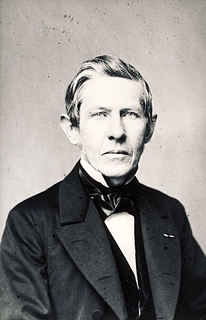
Fig. 7. Carl Ludvig Müller. The first curator of the Thorvaldsen Museum. 1868. 10.6×6.7 cm. The Royal Collection of Coins and Medals.
The Coin Collection in the Thorvaldsen Museum is, thus, a worthy monument to the endeavours of both P. O. Brøndsted and Thorvaldsen as coin collectors. It contains an intrinsically interesting numismatic material, which should be made accessible to international scholarship. 150 years have now passed since Thorvaldsen presented his collections, including the ancient coins, to his native city. Müller’s catalogue from 1850 is an admirable work, but the time has undoubtedly come for the publication of a new, thoroughly illustrated catalogue that can revive and extend our knowledge of Thorvaldsen’s collection.
Last updated 11.05.2017
